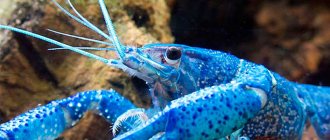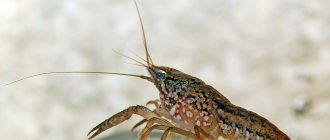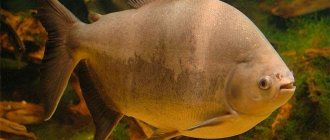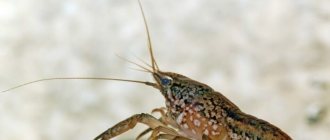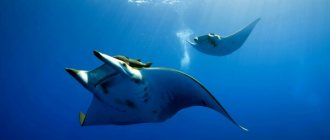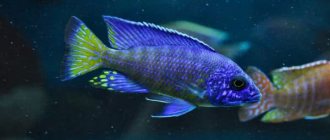Neon blue (Paracheirodon innesi) Myers, 1936.
Synonyms
Russian: Blue neon, Common neon, Neon tetra, Tetra neon Latin: Hyphessobrycon innesi, Cheirodon innesi
Etymology
Paracheirodon: From the Greek para meaning "associated with", and the generic name Cheirodon. innesi: named after the American aquarist, author, photographer, printer and publisher William T. Innes (1874-1969).
Family: Characinaceae Genus: Neons
History of discovery
These small fish owe their appearance in Europe to Auguste Rabaud, who was interested in exotic species of insects (primarily butterflies) and plants (orchids) for the collections of wealthy hobbyists and museums in different countries. He first saw this fish among the Indians when he was sick with fever. Neon floated in a clay vessel standing in the home. Rabo appreciated the find and, upon recovery, began work on transporting the fish to Europe. For a long time he hid the habitat of these luminous fish in order to maintain a monopoly on supplies. He sent several pieces to the famous tropical fish expert William Innes, who at that time was publishing Aquarium magazine in Philadelphia, in the hope that his magazine would create advertising for Rabo. Innes was surprised: it was the first time he had seen such wonderful fish. He immediately sent them for identification to one of the largest ichthyologists in the United States, Professor Myers, who described this species and gave it a specific name.
Feeding
Properly selected food plays a huge role in the life of fish. It should be nutritious, contain all the necessary vitamins and minerals and be in a form that is easy to eat.
Feeding neon
Neons are small fish that prefer the middle and lower layers of the aquarium. Tetra food is ideal for feeding them:
- TetraMin is a classic flake food suitable for all small and medium-sized ornamental fish. Made from more than 40 types of high-quality raw materials, it contains everything necessary for fish, including prebiotics for the proper functioning of the gastrointestinal tract. The flakes float and then slowly sink to the bottom, allowing fish to feed at different levels of the aquarium.
- Tetra Micro Pellets are small, slowly sinking pellets with a size of 0.4-1.2 mm. Ideal for fish with small mouths. The food is completely balanced, perfectly digestible, which reduces water pollution in the aquarium.
Range and Habitat
Neon blue (Paracheirodon innesi) distribution areas
South America: lives both in the tributaries of the Solimões River and in the forest tributaries of the Ucayali, Putumayo, Yarapa rivers (Peruvian part of the Amazon basin).
Neon blue (Paracheirodon innesi) habitat, Putumayo River
Even today, the true extent of its spread remains unclear.
Neon blue (P. innesi) habitats, black water tributaries
These are rivers and small streams with peat bottoms, flowing under a very dense canopy of trees. Light penetrates the water through dense foliage in negligible quantities, creating twilight. Leaves and branches falling into the reservoir, rotting, acidify the water, and a thick layer of silt makes it difficult to wash out and dissolve salts from bottom rocks. Precipitation that falls during the rainy season also replenishes water bodies. Therefore, the water here is exceptionally soft, acidic, transparent and enriched with tannins and humic substances, which give it a brownish tint.
Neon blue (P. innesi) wild trapping sites
The vast majority of fish available in the aquarium trade are commercially produced and are more adaptable than wild specimens.
Relatively compatible species
Barbs
Barbus
The main problem with keeping Barbs and Neons together is the difference in temperament. The barbs constantly scurrying back and forth create a little stress for the calmer neons. This problem is especially acute in small aquariums, where fish constantly meet each other.
Angelfish
Angelfish
For the cohabitation of neons and angelfish to be successful, it is best to keep the fish together from a young age. In such a situation, angelfish do not show aggression towards small characins. But it will most likely not be possible to add new neons to adult angelfish; there is a high probability that the small fish will be overrun by angelfish.
Marbled gourami
Marbled gourami
Even despite their size, gouramis have a rather peaceful disposition. However, sometimes they are able to attack small fish, especially shiny ones like neons. Keeping these species together requires control, and it is better if the fish live together from childhood.
Description
Apparently, in order to find each other in almost complete darkness, they have a bright stripe along the entire body, which, when exposed to the glare of the sun, flashes like a neon advertisement, either green or bright blue.
Under this stripe, starting from the middle of the body and to the beginning of the caudal fin, there is another, wider stripe of bright red color.
Size:
The female grows up to 35 mm, the male is usually 30 mm.
Basic content rules
In terms of content, blue neon is unpretentious. Even a small aquarium (at least 10 liters) is suitable for him, which does not need to be covered with a lid or glass: neons are nimble, but not jumping. It is better to purchase a flock of 5-6 or more individuals.
Don’t forget to create a favorable living environment
Basic parameters for comfortable maintenance:
- water - +18-24 degrees. Excessive temperatures can halve the life of fish;
- dH - 5-7;
- pH - 6.5-7;
- lighting is moderate. There must be shaded areas;
- aeration and filtration are required;
- the soil is dark. Against its background, the fish look brighter;
- vegetation - any living plants that do not interfere with the fish’s free swimming;
- decorations - mounds of stones, decorative grottoes, caves, castles, snags.
Behavior and Compatibility
The fish is peaceful, schooling, active, suitable for keeping in mixed aquariums.
Neon blue (Paracheirodon innesi) large group in an aquarium
It makes the greatest impression in large flocks of 20-30 or more individuals, together with species with similar conditions of detention and similar in size.
Neon blue (Paracheirodon innesi) in a community aquarium
Buy as many as possible from 10 or more, since with this quantity the fish are more active and less shy, more often visible and have better coloring, and exhibit more natural behavior.
The beauty secret of neon
The scales of neon, like any other fish, are transparent. Beneath the hard cover of this shingle-like protective layer is the skin, which contains special pigment-producing cells. They are called chromatophores or flower carriers.
The red neon stripe is formed by cells containing grains of red pigment. Black dye enters the chromatophores from the blood. Crystals of the substance guanine give a silvery-white color. When the crystals are concentrated around black and other dark pigment cells, the color produced is blue, indigo, or green, often with a metallic tint. This is how the coloring of a wide variety of fish species is formed.
Not only neons, but also many other inhabitants of the underwater world can glow with any part of their body. By the way, the pigments of fish scales do not emit light themselves, but reflect the rays falling on them.
The question inevitably arises: why do neons need their amazing shiny color?
In nature, nothing happens for nothing; any external sign and behavior are formed over many thousands of years under the influence of living conditions. So, is it beneficial for neons to have such a color? There is no exact explanation for this yet
Most likely, the brilliant color of neons helps them in the darkness of a tropical reservoir, during the spawning period, to attract the attention of individuals of the opposite sex
In addition, such coloring may not allow the predator to accurately target the prey at the moment of attack, when a school of fish scatters in all directions like sparkling splashes. After this, the neons again need to gather in a flock, find each other, and distinguish fellow tribesmen from strangers in low light.
Aquarium
Can be of any volume, preferably at least 40 cm in length and 30 cm in height.
Neon blue (Paracheirodon innesi) in aquarium 1
The content is relatively simple. The aquarium must be equipped in accordance with the conditions of the natural reservoirs where they are found. The lighting is moderate, with shadows. The soil is dark (basalt chips, boiled peat) and driftwood, densely planted with plants (Thai fern, cryptocorynes, pinnate, Java moss, etc.), with free places for swimming.
Neon blue diamond (Paracheirodon innesi) in an aquarium
They are unpretentious in terms of water composition, unless subsequent dilution is taken into account, and significant temperature fluctuations must be avoided. Prefers not too hard, slightly acidic water.
Neon blue (Paracheirodon innesi) in aquarium 2
Water parameters:
Temperature: 21 - 28° C pH: 4.0 - 7.5 Hardness: up to 12° dGH
Keep in mind that they, like most fish in this area of South America, can withstand some increase in nitrites and nitrates well, but do not tolerate large amounts of fresh water during water changes! It is better to replace in small portions, but more often.
Reviews
I really love neon fish: they attract with their exotic beauty. In my aquarium they live in schools of 12 individuals. If you are not going to breed fish, then their gender is not important: males and females are the same in color. Only the females are larger in appearance. I keep the flock in a 25 liter aquarium. In properly created conditions, neons live from 2 to 4 years. My flock is now 3.5 years old. Inga35
Neons are especially attractive when there are at least 10 of them in the aquarium. At high temperatures, bacteria appear in the water, which can become destructive to neons. I try to make sure that the temperature does not exceed 24-25°. I strongly recommend that everyone keep these fish in an aquarium with dense vegetation! This will ensure maximum similarity with the natural habitat. Peter B. 33 years old
Nutrition
In nature, it feeds on small invertebrates, crustaceans, filamentous algae, fallen fruits, and the like.
Neon blue (Paracheirodon innesi) nutrition
In aquariums, it can survive on a diet of dry food, but, like most fish, a varied menu is best, which in this case should contain live and frozen food - it should be small enough - the fish has a small mouth.
Fish ailments
Unfortunately, even under optimal conditions, neon babies can get sick. It’s good if the disease turns out to be curable, and the owner is vigilant. Then the fish has a good chance of being saved. But there are also incurable diseases that the owner needs to know about. Here are some diseases of common neons:
In fish with neon disease, the neon stripes begin to fade and disappear.
- Neon disease. This is an incurable fungal infection of the body of the neon fish, from which it quickly dies. If the neon strip has faded and the fish refuses to eat, there is a high probability that the pet is sick. As a rule, in this case the entire aquarium is susceptible to rapid death, and the owner can only liquidate the contents and disinfect the container with soil .
- Dermatocystidiasis. Thin white “worms” – cysts – form on the body of the neon fish. Disputes develop within each entity. Parasites infect fish until vital organs cease to function. The chances of survival are minimal. However, there are cases where the elimination of sick fish helped save the remaining individuals from infection.
- Fin rot. The negligence of the owner is the main cause of this disease. If the water in the aquarium is of consistently poor quality, the fins will begin to decompose. But, fortunately, timely measures save the entire flock, including those who are sick.
Sexual Dimorphism
Sex differences in fish are weakly expressed. Mature females are usually noticeably rounder and slightly larger than males.
Neon blue (P. innesi) male
Neon blue (P. innesi) female
The female has a fuller abdomen and a bent green stripe, while males have a more slender body and a straight stripe. In addition, in males the swim bladder, which is visible through the body, is shifted towards the anus, while in females it is closer to the spine.
Blue neons become sexually mature at 5-8 months.
Choosing neighbors for our neons
Neons can rightfully be called one of the most easy-going and good-natured aquarium fish, which, for their part, are unlikely to show any aggression or intolerance towards other inhabitants of the aquarium.
However, even though neons are able to coexist perfectly with most of their neighbors, some recommendations in this regard will not be superfluous. Moreover, there are exceptions. But first things first.
The best compatibility of blue neons is observed in the vicinity of fish species such as zebrafish, swordtail, gupia and mollies.
The general list of aquarium inhabitants suitable for keeping in the same tank with neons is as follows:
- cockerels;
- Tarakatum catfish;
- battles;
- gourami;
- tetras;
- angelfish;
- snails;
- shrimps;
- Ancistrus;
- tensions;
- barbs;
- cardinals;
- iris;
- corridors.
Now we present a list of fish that, for one reason or another, will become undesirable neighbors for neons.
These include:
- gold fish
- cichlids, especially Astronotus
- piranha
- mosquerot
- tetradont
All of these fish pose a natural danger to little neons. These are significantly larger species, especially since most of them are predators.
Breeding
Reproduction requires certain knowledge of hydrochemistry and experience in fish farming. The main condition is careful preparation of producers, spawning grounds and, especially, water.
Adult fish should not be used for breeding purposes. When preparing full-fledged breeders, you should take young individuals 2-3 months old, which are kept in certain conditions. The aquarium is filled with long-aged tap water with the addition of 1/4 part of distilled or pure rainwater. Males and females are kept separately and, regardless of the time of year, are fed live food, excluding the tubifex. It is enough to give daphnia and cyclops, as well as small bloodworms and coretra.
The water in the spawning area should be very soft (0.5-4°) and acidic (pH 5.5-6.5) with a temperature of 22-24° C.
For spawning they are planted either in pairs or in a flock of 5-10 pairs. To do this, it is necessary to select females with the same readiness for spawning. For one pair of producers, 5-6 liters of prepared water can be used.
Neon blue (P. innesi) producers, preparation, breeding
It has been established that acidic water has bacteriostatic properties, that is, it inhibits the development of bacteria. This property is of great practical importance for fish breeding. It is known that in hard water (above 4-5°), the egg shell of many characins becomes impermeable to sperm, and fertilization does not occur. Therefore, it is necessary to artificially prepare water for spawning grounds. It is enough to take 10 liters of distilled water and add 1 liter of tap water. Place the container with soft water in a dark place and let it sit for two weeks. When acidifying water, you cannot use mineral salts, as well as sulfuric, nitric, phosphoric and other acids.
Spawning tank with mesh for Neon Blue
For breeding, all-glass aquariums are used, which must be thoroughly washed and disinfected. At the bottom it is enough to put a separator mesh or lattice and a bunch of Java moss. It is advisable to cover the spawning area with dark green paper on three sides; diffused light should enter it from the fourth. The water in the spawning area should be slightly aerated with small air bubbles.
Neon blue (P. innesi) spawning ground, producers, spawning, breeding
Mature spawners are placed for spawning in the evening. The fish are not fed in the spawning area. Spawning usually begins the next morning. After laying the eggs (within 3-4 hours), the spawners are removed with a disinfected net, and trypaflavin is added to the water until it turns a soft yellow color. The spawning area is completely darkened. During spawning, the female throws out from 100 to 250 eggs. The males are placed in a reserve aquarium. This is done because females collect eggs after 7-10 days for the next spawning, while males are fully ready only after 15-20 days. Consequently, for the next spawning, other, unspawned males are added to the females. 20-24 hours after the end of spawning, larvae hatch from the eggs.
The larvae are equipped with yolk sacs, through which they feed, develop and turn into fry over 5-6 days. From this moment they begin to feed the fry. One half of the aquarium is slightly illuminated so that the fry, gathering in a darkened area, better take food in the illuminated part. They are fed with zooplankton sifted through a thick sieve and mixed with rotifers, which are the best starter food for neon fry.
We must remember that at first the aquarium with fry should not be brightly lit. The darkening is removed only at the moment when the fry are sufficiently strong, i.e. in 12-14 days. This period is the most crucial in raising fry, because... Due to their low motor activity in water, it is necessary to maintain a high density of food organisms. At 14-15 days, the fry can already eat small daphnia and cyclops. During this period, a red stripe appears on their body, and they become similar to their parents. The fry can be transferred to a large aquarium without soil, with water of the same composition and temperature as in the spawning tank. As the juveniles grow, water is added in small portions to the nursery aquarium in which they will be kept in the future (for gradual adaptation to the quality of the aquatic environment). The most negative factor for juveniles is a high level of protein substances and an excessive amount of bacteria in the water.
Neon blue diamond (P. innesi) is an excellent choice for an aquarium
Life expectancy in an aquarium is about 3 years.
Reproduction
Under natural conditions, the process of reproduction of exotic fish occurs during the rainy season. Therefore, when planning spawning in an aquarium, it needs to be stimulated and the water, which individuals mistake for rain, needs to be regularly changed. In addition, you need to prepare a spawning area and, if possible, move future parents there.
Eggs spawned in a community aquarium have less chance of maturing.
Most attempts to produce neon offspring will be unsuccessful. The fact is that the small eggs laid are eaten almost immediately. The offspring can be saved if you observe the behavior of individuals for a long time, and as soon as the eggs are laid, immediately move them to another container.
What conditions should be created for spawning:
- water acidity – up to 5 pH;
- hardness – up to 4 dH;
- temperature – 26C;
- dim lighting;
- the presence of live food (frozen can be an alternative, but dry food is not);
- minimum vegetation - several plants will be needed to attach the eggs.
In conditions comfortable for spawning, individuals begin active mating games. At first, they actively swim around the spawning ground, and then eggs are laid. Small eggs cling to plants, and after a few hours fall to the bottom of the container. At this point, there is a high chance that they will be eaten by other inhabitants of the aquarium. Therefore, the introduction of neon offspring into the spawning area is mandatory.
Neon crumbs hatching from caviar.
A competent approach to the maintenance of neons and the creation of comfortable conditions for them will allow you to enjoy their beauty for 4 years. And if you manage to breed healthy offspring, then blue neons will become a decoration for any aquarium for a long time.
Notes
One of the most popular and recognizable fish in the aquarium hobby, this variety has been selectively bred into a number of additional forms, including albino, "golden", short-bodied, veil and "diamond" (which have shiny scales on the back).
Tetra neon Golden diamond veil (P. innesi) selection form
Unfortunately, years of commercial breeding have somewhat affected the genetic strength of the ornamental strain, meaning that morphological defects and poor health are widespread.
The most common disease is plystophorosis. In sick fish, the color fades, the brightness of the neon strip disappears, and coordination of movements is impaired: they hold their tail down at an angle of 45-60°. Trying to get out of this position, they make jerky upward movements. They stop taking food. Treatment for the disease has not been developed. If it occurs, fish, plants, snails must be destroyed, the aquarium, nets must be disinfected, and the soil must be calcined or boiled.
identification:
Coloration is perhaps the most convenient method of identification for aquarists; differences in the color structure of P. innesi can be distinguished from its relatives Red Neon (P. axelrodi) and Green Neon (P. simulans).
P. innesi differs from P. axelrodi in that it has relatively less red pigment on the body, a narrower blue lateral stripe, and a more distinct white line on the anal fin.
Green neon (P. simulans) similar species
It is distinguished from P. simulans by having a bluer (versus greener) lateral stripe that extends only to the adipose fin (versus the base of the caudal fin), more red pigment on the sides, and a more distinct white marking on the anal fin.
Diseases
Thanks to their strong immune system, common neons rarely get sick. As practice shows, weakened individuals are mainly susceptible to infection. The most common disease that affects aquarium fish is plistiphorosis.
Symptoms:
- The first thing that catches your eye when a fish gets sick is the dimming and then the disappearance of the distinctive feature of the species - the luminous stripe. After some time, the body color fades.
- Refusal of food. Active movement around the aquarium, throwing around the aquarium, sunken abdomen.
- The body of the individual becomes thin, this is visible to the naked eye. When moving in water, the body tilts unnaturally to the side, and the tail is strongly lowered. It is not easy to return neons to their normal position: such attempts turn out to be failures.
- As a result of being in an uncomfortable position for a long time, curvature of the spine occurs.
- The destruction of the fins begins.
The disease is considered infectious, it is extremely difficult to prevent, and it cannot be treated. The only way out will be to destroy all the individuals in the artificial reservoir, and then it will need to be thoroughly disinfected.
Diseased neon loses its brightness, the fins stick together, and the fish’s behavior becomes uncharacteristic.
Sometimes there is a false neon pathology. The main difference from plistiphorosis is the bacterial causative agent of the infection. A false disease can be cured. A laboratory test will be needed to make a diagnosis. Only after this will treatment be prescribed: for this purpose, it is recommended to add levomycin, kanamycin or biseptol to the water.


